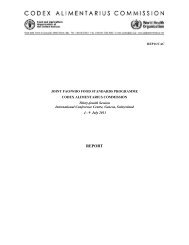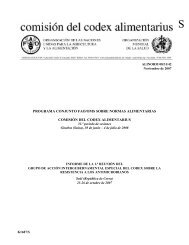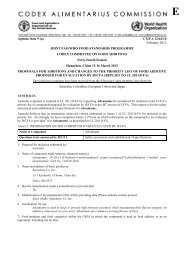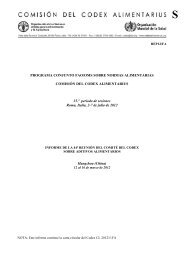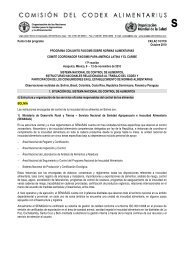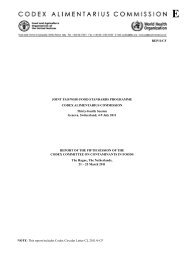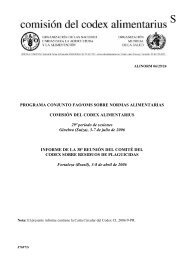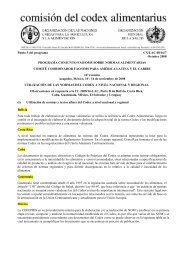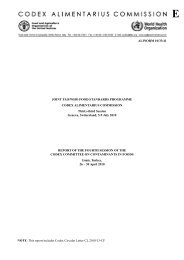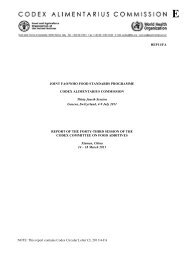Report of the 33rd Session of the Codex Committee on Nutrition and ...
Report of the 33rd Session of the Codex Committee on Nutrition and ...
Report of the 33rd Session of the Codex Committee on Nutrition and ...
- No tags were found...
Create successful ePaper yourself
Turn your PDF publications into a flip-book with our unique Google optimized e-Paper software.
REP 12/NFSDU Appendix IV 506.2 Energy6.2.1 The energy density <str<strong>on</strong>g>of</str<strong>on</strong>g> a mixture <str<strong>on</strong>g>of</str<strong>on</strong>g> milled cereals <strong>and</strong> pulses <strong>and</strong> defatted oilseed meals <strong>and</strong>flours <strong>on</strong> dry weight basis is relatively low.6.2.2 The energy density <str<strong>on</strong>g>of</str<strong>on</strong>g> <str<strong>on</strong>g>the</str<strong>on</strong>g> food can be increased during manufacture by <str<strong>on</strong>g>the</str<strong>on</strong>g> additi<strong>on</strong> <str<strong>on</strong>g>of</str<strong>on</strong>g> energyc<strong>on</strong>taining ingredients ( i.e. fats <strong>and</strong> oils <strong>and</strong>/or digestible carbohydrates) <strong>and</strong>/or processing <str<strong>on</strong>g>the</str<strong>on</strong>g> basicraw materials <strong>and</strong> ingredients as indicated in Secti<strong>on</strong> 5.6.2.3 The energy density <str<strong>on</strong>g>of</str<strong>on</strong>g> <str<strong>on</strong>g>the</str<strong>on</strong>g> Formulated Complementary Food should be at least 4 kcal per gram<strong>on</strong> dry weight basis.6.3 Proteins6.3.1 Mixtures <str<strong>on</strong>g>of</str<strong>on</strong>g> cereals, legumes, pulses <strong>and</strong>/or oilseed flours, can c<strong>on</strong>stitute an appropriate source<str<strong>on</strong>g>of</str<strong>on</strong>g> proteins, provided that <str<strong>on</strong>g>the</str<strong>on</strong>g> proteins in <str<strong>on</strong>g>the</str<strong>on</strong>g> Formulated Complementary Food satisfy <str<strong>on</strong>g>the</str<strong>on</strong>g> criteriabelow. Protein quality can also be improved by <str<strong>on</strong>g>the</str<strong>on</strong>g> inclusi<strong>on</strong> <str<strong>on</strong>g>of</str<strong>on</strong>g> fish products, milk <strong>and</strong> milk products<strong>and</strong>/or o<str<strong>on</strong>g>the</str<strong>on</strong>g>r animal source foods.6.3.2 The Protein Digestibility Corrected Amino Acid Score (PDCAAS) 7,8,9 should not be less than 70per cent <str<strong>on</strong>g>of</str<strong>on</strong>g> that <str<strong>on</strong>g>of</str<strong>on</strong>g> <str<strong>on</strong>g>the</str<strong>on</strong>g> WHO amino acid reference pattern for children from 2 – 5 years .6.3.3 If, for technical reas<strong>on</strong>s, <str<strong>on</strong>g>the</str<strong>on</strong>g> PDCAAS digestibility <str<strong>on</strong>g>of</str<strong>on</strong>g> a protein cannot be determined, <str<strong>on</strong>g>the</str<strong>on</strong>g>protein quality should be measured by biological assays. Alternatively, <str<strong>on</strong>g>the</str<strong>on</strong>g> protein quality may becalculated from published data <strong>on</strong> essential amino acid patterns <str<strong>on</strong>g>of</str<strong>on</strong>g> dietary proteins <strong>and</strong> <str<strong>on</strong>g>the</str<strong>on</strong>g>irdigestibility.6.3.4 The additi<strong>on</strong> <str<strong>on</strong>g>of</str<strong>on</strong>g> methi<strong>on</strong>ine, lysine, tryptophan or o<str<strong>on</strong>g>the</str<strong>on</strong>g>r limiting amino acids, solely in <str<strong>on</strong>g>the</str<strong>on</strong>g> L-form should be c<strong>on</strong>templated <strong>on</strong>ly when, for ec<strong>on</strong>omic <strong>and</strong> technological reas<strong>on</strong>s, no mixture <str<strong>on</strong>g>of</str<strong>on</strong>g>vegetable <strong>and</strong>/or animal proteins makes it possible to obtain an adequate protein quality (see 6.3.2).6.3.5 Taking into account <str<strong>on</strong>g>the</str<strong>on</strong>g> preceding c<strong>on</strong>siderati<strong>on</strong>s, <str<strong>on</strong>g>the</str<strong>on</strong>g> energy from protein 10 should not be lessthan 6 % <str<strong>on</strong>g>of</str<strong>on</strong>g> <str<strong>on</strong>g>the</str<strong>on</strong>g> total energy from <str<strong>on</strong>g>the</str<strong>on</strong>g> product <strong>and</strong> typically should not exceed 15% 116.4 Fat6.4.1 Incorporati<strong>on</strong> <str<strong>on</strong>g>of</str<strong>on</strong>g> fats <strong>and</strong>/or oils in Formulated Complementary Foods serves to increase <str<strong>on</strong>g>the</str<strong>on</strong>g>energy density <strong>and</strong> <str<strong>on</strong>g>the</str<strong>on</strong>g> amount <str<strong>on</strong>g>of</str<strong>on</strong>g> essential fatty acids as well as reduce total volume <str<strong>on</strong>g>of</str<strong>on</strong>g> <str<strong>on</strong>g>the</str<strong>on</strong>g> foodc<strong>on</strong>sumed. At least 20 % <str<strong>on</strong>g>of</str<strong>on</strong>g> energy derived from fat 10 is desirable.6.4.2 The level <str<strong>on</strong>g>of</str<strong>on</strong>g> linoleic acid (in <str<strong>on</strong>g>the</str<strong>on</strong>g> form <str<strong>on</strong>g>of</str<strong>on</strong>g> glycerides) should not be less than 333 mg per 100kcal or 1.6 g per 100 g <str<strong>on</strong>g>of</str<strong>on</strong>g> dry productError! Bookmark not defined.<strong>and</strong> <str<strong>on</strong>g>the</str<strong>on</strong>g> fat or oil used in <str<strong>on</strong>g>the</str<strong>on</strong>g>producti<strong>on</strong> <str<strong>on</strong>g>of</str<strong>on</strong>g> Formulated Complementary Foods should ensure a ratio between linoleic acid <strong>and</strong>alpha-linolenic acid <str<strong>on</strong>g>of</str<strong>on</strong>g> between 5:1 <strong>and</strong> 15:1.6.4.3 The use <str<strong>on</strong>g>of</str<strong>on</strong>g> edible oils c<strong>on</strong>taining polyunsaturated fatty acids, including omega-3 fatty acids <strong>and</strong>in particular docosahexaenoic acid, should be c<strong>on</strong>sidered. The levels in <str<strong>on</strong>g>the</str<strong>on</strong>g> WHO/FAOrecommendati<strong>on</strong>s (FAO/WHO Expert c<strong>on</strong>sultati<strong>on</strong> <strong>on</strong> Fats <strong>and</strong> fatty acids in human nutriti<strong>on</strong>,GenevaError! Bookmark not defined.) may be c<strong>on</strong>sidered.6.5 Carbohydrates6.5.1 Starch is likely to be a major c<strong>on</strong>stituent <str<strong>on</strong>g>of</str<strong>on</strong>g> many Formulated Complementary Foods. Toensure that its energy value is realized, this starch should be provided in a readily digestible form.Guidance <strong>on</strong> increasing <str<strong>on</strong>g>the</str<strong>on</strong>g> digestibility <str<strong>on</strong>g>of</str<strong>on</strong>g> starches is given in Secti<strong>on</strong> 5. [If nutritive sweeteners areused, <str<strong>on</strong>g>the</str<strong>on</strong>g>y should be used sparingly.]7891013PDCAAS (%)= mg <str<strong>on</strong>g>of</str<strong>on</strong>g> limiting amino acid in 1 gram <str<strong>on</strong>g>of</str<strong>on</strong>g> test protein X faecal true digestibility <str<strong>on</strong>g>of</str<strong>on</strong>g> test protein X 100mg <str<strong>on</strong>g>of</str<strong>on</strong>g> limiting amino acid in 1 gram <str<strong>on</strong>g>of</str<strong>on</strong>g> reference proteinThe limiting amino acid is <str<strong>on</strong>g>the</str<strong>on</strong>g> essential amino present in <str<strong>on</strong>g>the</str<strong>on</strong>g> lowest proporti<strong>on</strong> as compared with <str<strong>on</strong>g>the</str<strong>on</strong>g> quantity <str<strong>on</strong>g>of</str<strong>on</strong>g> thisamino acid reference patternSarwar, G., J. Nutr. 1997, 127:758-764.C<strong>on</strong>versi<strong>on</strong> factor based <strong>on</strong> <str<strong>on</strong>g>Codex</str<strong>on</strong>g> Guidelines <strong>on</strong> Nutriti<strong>on</strong> Labelling (CAC/GL 2-1985)Michaelsen KF et al. 2009. Food <strong>and</strong> Nutr Bull 30:343-404



